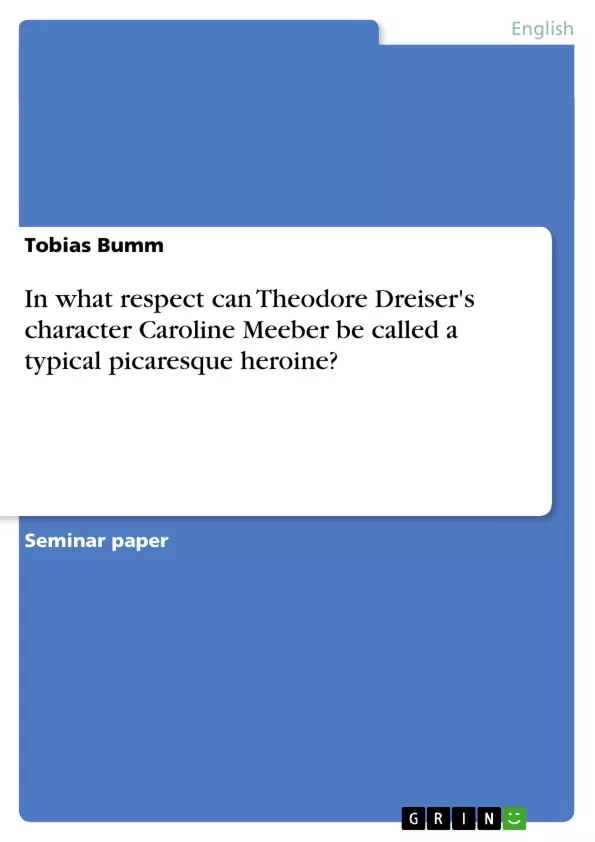Caroline Meeber is one of the most fascinating characters American author Theodore Dreiser ever came up with. The life sequences she goes through have got a picaresque dimension comparable with the bildungsroman. I want to examine in how far those picaresque elements are of deep importance for the work itself. Is this Dreiser novel a real picaresque masterpiece or does he only use certain features of the respective genre?
Inhaltsverzeichnis (Table of Contents)
- Introduction
- Category No. 1:
- Narrative Perspective
- Category No. 2:
- Origins
- Category No. 3:
- Episodic Structure
- Category No. 4:
- Masters of a picaresque hero.
- Category No. 5:
- Picaresque hero as an outsider
- Category No. 6:
- Satire of the world
- Category No. 7:
- Moral comment
- Conclusion
Zielsetzung und Themenschwerpunkte (Objectives and Key Themes)
This paper examines the character of Caroline Meeber in Theodore Dreiser's "Sister Carrie" to determine whether she can be considered a typical picaresque heroine. It utilizes key categories of a picaresque hero, as outlined by Harry Sieber and Chris Baldick, to analyze Caroline's portrayal and compare her to other picaresque figures in literature.
- The role of narrative perspective in defining a picaresque hero
- The significance of origins and social background in shaping a picaresque protagonist
- The episodic structure and its relation to picaresque conventions
- The influence of external forces, like masters and society, on a picaresque hero
- The use of satire to critique societal norms and values in picaresque literature
Zusammenfassung der Kapitel (Chapter Summaries)
The introduction provides an overview of the paper's focus on analyzing Caroline Meeber's character and exploring her potential as a picaresque heroine. It establishes the theoretical framework by referencing works of Harry Sieber and Chris Baldick, who define key elements of picaresque literature. The introduction also emphasizes the multifaceted and open-ended nature of defining a picaresque hero.
Chapter 1 explores the narrative perspective in "Sister Carrie" and its deviation from the typical first-person narration found in many picaresque novels. It contrasts the third-person narration in Dreiser's work with the direct, subjective accounts of protagonists like Huckleberry Finn in "The Adventures of Huckleberry Finn."
Chapter 2 delves into the origins and background of Caroline Meeber, examining her transition from a small-town Wisconsin girl to a woman seeking success in Chicago at the end of the 19th century. The chapter emphasizes the socio-economic context that shapes Caroline's aspirations for wealth and social status.
Chapter 3 focuses on the episodic structure of "Sister Carrie," exploring how the narrative unfolds through a series of interconnected events and encounters. The chapter analyzes whether this episodic structure aligns with the typical picaresque pattern, where a protagonist navigates a series of adventures.
Schlüsselwörter (Keywords)
The paper explores the character of Caroline Meeber in Theodore Dreiser's "Sister Carrie," analyzing her potential as a picaresque heroine. Key themes include the role of narrative perspective, the impact of origins and social background, and the relevance of episodic structure in shaping a picaresque protagonist. The paper explores the conventions of the picaresque novel, referencing works of Harry Sieber and Chris Baldick, and examines how "Sister Carrie" fits into this genre.
- Arbeit zitieren
- Tobias Bumm (Autor:in), 2002, In what respect can Theodore Dreiser's character Caroline Meeber be called a typical picaresque heroine?, München, GRIN Verlag, https://www.grin.com/document/10830



